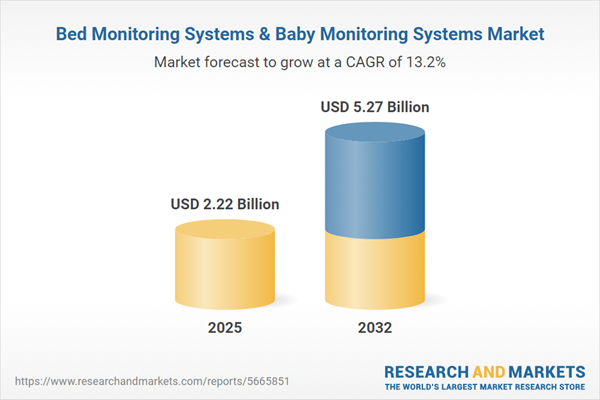Speak directly to the analyst to clarify any post sales queries you may have.
The bed monitoring systems & baby monitoring systems market is experiencing rapid transformation as healthcare organizations and families increasingly incorporate digital health technologies into daily care routines. As innovative monitoring solutions become essential tools in both clinical and home environments, leaders face critical choices in aligning strategy, technology adoption, and operational priorities to maintain a competitive edge.
Bed Monitoring Systems & Baby Monitoring Systems Market Snapshot
Adoption of integrated monitoring technologies is reshaping how healthcare providers and caregivers oversee patient safety in global markets. Real-time surveillance now supports prompt intervention for vulnerable populations, spanning at-risk adults and infants. Digitization is enhancing health management and communication among care teams, helping to bridge gaps between clinical workflows and patient-centered care. As organizations adapt to higher benchmarks in interoperability, their operations more readily scale across diverse regional healthcare landscapes. This dynamic sector is firmly positioned at the heart of evolving patient care strategies, as solutions increasingly support both acute and home-based services.
Scope & Segmentation of the Bed Monitoring Systems & Baby Monitoring Systems Market
- Product Type: Mattress sensors, wearable monitoring devices, camera-integrated monitors, radar detection systems, and acoustic monitoring solutions all offer tailored safety oversight. These product categories enable flexible deployment across hospital and residential settings, accommodating a range of patient requirements.
- Monitoring Technology: Acoustic signal processing, visual imaging, radar sensing, and advanced pressure sensors form the technological backbone of comprehensive patient assessment, enabling rapid clinical decision-making.
- Application: Solutions address multiple care needs, including cardiovascular monitoring, respiratory function tracking, movement detection, and identification of sleep disturbances, supporting early, individualized interventions.
- End User: Hospitals, ambulatory centers, and home care providers increasingly rely on these systems to improve oversight and coordinate efficient care among various patient segments.
- Age Group: Purpose-built devices for newborns, infants, and toddlers are enhancing early childhood safety and reducing developmental risk during critical years.
- Distribution Channel: Monitoring solutions reach end users via direct purchasing, offline retail, and online sales, helping providers and families access life-safety technologies that match changing care demands.
- Regional Coverage: The market extends across the Americas, Europe, Middle East & Africa, and Asia-Pacific, with each region reflecting different technology adoption rates, regulatory standards, and investments in healthcare infrastructure.
- Key Companies Analyzed: Major manufacturers—including Koninklijke Philips N.V., General Electric Company, Baxter International Inc., Drägerwerk AG & Co. KGaA, Smiths Group plc, Stryker Corporation, Motorola Solutions, Inc., VTech Holdings Limited, Ascom Holding AG, and Stanley Black & Decker, Inc.—are actively contributing to innovation and product line expansion in the monitoring space.
Key Takeaways for Senior Decision-Makers
- Advanced bed and baby monitoring systems are integrating real-time analytics, equipping care teams with actionable insights to support timely responses and strengthen risk oversight in clinical and residential care.
- The use of edge computing and artificial intelligence improves anomaly detection and intervention strategies, benefiting patient safety across age groups and risk categories.
- Enhanced interoperability with electronic health records and telemedicine platforms helps minimize workflow interruptions, creating efficiency gains for providers while reducing administrative complexity.
- Contactless monitoring such as radar and acoustic-based solutions is elevating patient comfort and lowering infection risks, a key consideration for deploying technology in sensitive care environments.
- Multi-channel distribution increases the agility of procurement, supporting operational resilience and more flexible supply chain management for healthcare organizations and families.
Tariff Impact on the U.S. Market
Recent changes in tariffs are affecting supply chains for bed monitoring systems & baby monitoring systems within the United States. Industry leaders are addressing these challenges by shifting towards nearshoring, broadening their supplier base, and introducing higher levels of automation—measures intended to maintain regulatory compliance and assure reliable, cost-effective access to essential products.
Methodology & Data Sources
This report draws upon first-hand perspectives from clinicians, hospital managers, and device manufacturers, supported by validation through regulatory documentation and peer-reviewed research. Such a methodology ensures that decision-makers receive relevant, best-practice intelligence on the evolving market for bed and baby monitoring systems.
Why This Report Matters
- Enables targeted resource planning by offering in-depth analysis of emerging monitoring solutions and their relevance to acute and home care operations.
- Supports adaptation to new regulatory frameworks and digital health integration, contributing to streamlined coordination and improved team workflows.
- Delivers clear guidance for process enhancement and greater flexibility, ensuring sustainable and resilient approaches to shifting healthcare demands.
Conclusion
As the market for digital health and monitoring platforms advances, organizations committed to seamless integration and adaptable operations will be best positioned to meet future care challenges and foster lasting success.
Additional Product Information:
- Purchase of this report includes 1 year online access with quarterly updates.
- This report can be updated on request. Please contact our Customer Experience team using the Ask a Question widget on our website.
Table of Contents
3. Executive Summary
4. Market Overview
7. Cumulative Impact of Artificial Intelligence 2025
Companies Mentioned
The companies profiled in this Bed Monitoring Systems & Baby Monitoring Systems market report include:- Koninklijke Philips N.V.
- General Electric Company
- Baxter International Inc.
- Drägerwerk AG & Co. KGaA
- Smiths Group plc
- Stryker Corporation
- Motorola Solutions, Inc.
- VTech Holdings Limited
- Ascom Holding AG
- Stanley Black & Decker, Inc.
Table Information
| Report Attribute | Details |
|---|---|
| No. of Pages | 192 |
| Published | October 2025 |
| Forecast Period | 2025 - 2032 |
| Estimated Market Value ( USD | $ 2.22 Billion |
| Forecasted Market Value ( USD | $ 5.27 Billion |
| Compound Annual Growth Rate | 13.1% |
| Regions Covered | Global |
| No. of Companies Mentioned | 10 |









